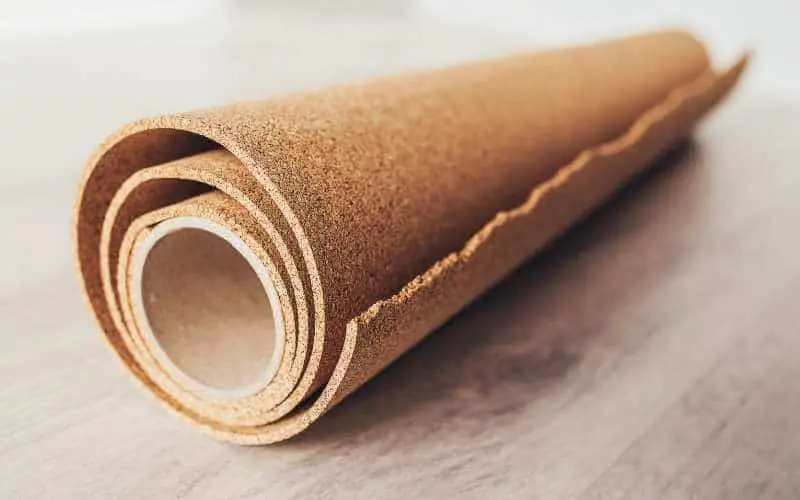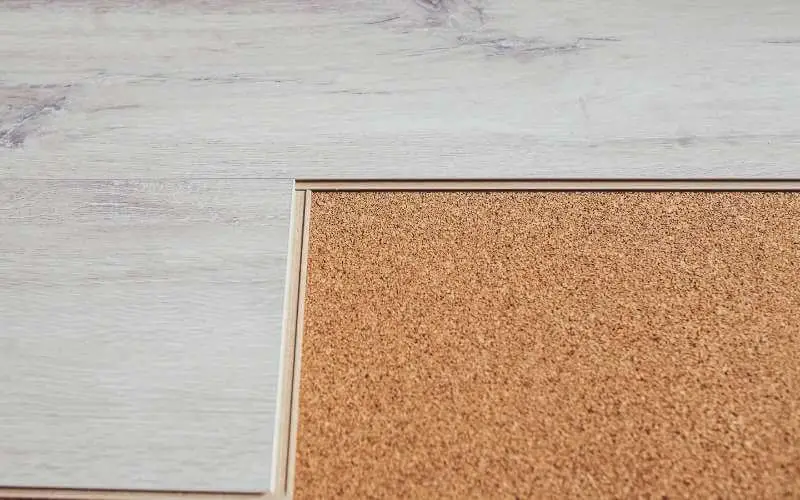During the laminate floor installation, underlay is firstly installed on a subfloor, and the laminate floorboards are placed over the thin, flexible sheet of resilient underlayment material.
Underlay acts as a base for the laminate planks or tiles you’re installing and provides support to the flooring material. The importance of installing underlay underneath laminate floor cannot be overemphasized.
The best underlay for laminate floor is very thin foam layers that slightly cushion the flooring but also keep the floor stable and prevent noticeable movement underfoot.
With several functions ranging from evening out the flooring; cushioning feet fall on the laminate planks; and slightly improving the floor’s R-value (its resistance to heat transmission), you can already tell it is very important to choose the best underlay for laminate floor, and they also need to be installed properly as well.
Related: 4 Reasons your Laminate Flooring Feels Bouncy
What Is the Best Underlay for Laminate Floor?
Table of Contents
Determining the best underlay for a laminate floor depends on a couple of factors, like the installation environment, the type of subfloor, and the use of the space.
Overall, the best underlay for laminate floor is very thin foam layers that slightly cushion the flooring but also keep the floor stable and prevent noticeable movement underfoot.
Most underlayments can be applied over the subfloor by rolling them out and secured in place with adhesive strips, which are sometimes preattached to the underlayment.
A laminate floor cannot use an underlayment that is soft and thick like carpet padding; these types of underlay don’t make the laminate floor any better or more comfortable to walk across; instead, they may cause the floor to move in a manner that can loosen the plank joints.
To choose the right underlay for laminate floor lookout for features like:
- Leveling
- Sound insulation
- Heat insulation
- Compatability with underfloor heating
- Suitability for heavy traffic areas
- Moisture barriers (for concrete or areas with slightly elevated moisture levels)
Different Types of Laminate Underlayment
Now that you know the qualities that make an underlay the best for a laminate floor, you may want to familiarize yourself with the different types of laminate underlayment; there are four types of underlayment options they include;
Foam
This is the most basic variety of laminate floor underlayment. Foam underlay is a thin layer of foam material, around 1/8 inches thick.
This underlay is commonly used in residential spaces because it is super affordable, versatile, and installed easily; their low cost does not indicate any shortcoming when in their effectiveness in terms of being an excellent cushion between the subfloor and laminate or other types of flooring installed over the underlay material.
However, the standard foam underlayment is not suited for high moisture areas because they lack an ideal vapor barrier. Some underlay manufacturers produce a combination foam underlay which is a combination of foam underlay with a vapor barrier attachment.
These variants of foam underlay may cost a few extra bucks but can be installed in different subfloors such as concrete, OSB, or plywood subfloor in basements, bathrooms, and kitchens.
Felt
Felt underlayment is an eco-friendly underlay option made from recycled fibers; felt underlayments are denser compared to foam and are excellent sound absorbers that improve the home’s insulation and make walking across the floor comfortable.
Some felt underlay is developed with a built-in moisture barrier that helps to protect the floor from moisture infiltration; felt underlay can be used for different flooring types like laminate, vinyl, and hardwood.
Rubber
The easy installation process is the reason why people opt for rubber underlayment. They are extremely versatile and are one of the most sound-absorbing and insulating underlayments available.
Being made from recycled rubber product makes this underlay utterly impervious to any mold, mildew and silences any noise associated with a concrete or wood subfloor.
However, the downside of using rubber underlay is that they are limited to certain types of flooring. They can’t be used on some floors, such as a vinyl floor; this is due to their ability to stain, but if the best underlay for a laminate floor is what you are looking for, then you can totally opt for rubber.
Rubber is more commonly used with wood, tile, or carpet floors. There is also a combination felt underlay that is a merge of rubber and cork; the resulting underlayment expertly prevents cracks and gap formation in the laminate floorboards, as they withstand house settling and natural movement that could create such problems.
Cork
The last but not least type of underlayment for laminate flooring discussed in this article is cork. They are excellent at serving as soundproof underlayment because cork is a natural material with enough bounce and density; it balances the weight and pressure it receives without losing its original shape.
A cork underlayment provides good insulation and natural antimicrobial capabilities that keep mold growth between your subfloor and laminate flooring at bay.
Placing a sheet of plastic under the cork underlay will help to increase the efficacy of the moisture barrier.
Cork underlay can help even out any subfloor imperfection on surfaces between rooms, but it may not be the most comfortable underlay to walk over, and they are also very expensive; you may expect a 50% increase in your floor installation costs by using cork underlay.
Read: How to Make Laminate Floors Less Slippery
Brands of the Best Underlay for Laminate Floor
1. Roberts First Step 630-Square Foot Roll Underlayment
- Price per 630 sq.ft roll
- 3mm thick comes with overlap and tape to install
- Suitable for concrete and wood subfloors
- Use with engineered hardwood, solid hardwood, or laminate flooring
- Fast & Free Fedex Ground
Last update on 2022-04-20 / Affiliate links / Images from Amazon Product Advertising API
Roberts is one of the best underlay for laminate floor, with multiple layers that guarantee protection, comfort, and sound absorption.
The first layer of this product is its styrofoam bead layer, which serves as a cushioning system between the subfloor and underlayment, but the space for air movement is present and helps to prevent mold growth. The thickness of the underlay enables it to fix small imperfections in the subfloor and inconsistencies in the seams.
It features a vapor barrier that protects your flooring against moisture. Installing this product is as easy as it gets; they come with a sizable adhesive strip that allows for ample 4-inch overlap; this ensures the gaps are closely fitted and will not allow moisture through.
Roberts underlayment is also effective in sound absorption, making it suitable for use on upper floors. A single roll of this underlayment covers around 630 square feet.
Pros
- Equipped with features that ensure airflow and anti-mold growth
- A single roll is of the product covers about 630 square feet of flooring
- The adhesive strip and 4-inch overlap they come with make for easy installation
Cons
- This underlayment is best used for concrete slabs and wood subfloors on or above grade.
2. Roberts 100 Sq. Ft. Roll Serenity Foam Underlayment
- 100 sq. ft. coverage with roll measuring 25 ft. x 4 ft. x 3/32 in
- To be used for wood subfloors
- Can also be used with concrete slabs with recommended Moisture Barricade (Item# 70-115, sold separately)
- For use under laminate and engineered wood flooring
- Can be used over radiant heated floors
Last update on 2022-04-20 / Affiliate links / Images from Amazon Product Advertising API
This is another Roberts underlayment suitable for homes with wood subfloors, which do not require a moisture barrier. It is a 2.4-millimeter polyethylene foam underlayment, which comes in 100-square-foot rolls.
It cushions your feet as you walk across the flooring and smooths out minor imperfections in the subfloor, which results in a more leveled laminate flooring installation. This underlayment can be used for radiant heated floors and even concrete floors when combined with a vapor barrier.
This underlayment is quite affordable, but it does not include the built-in adhesive strips for easy installation, and each roll of the product is 25 feet long and 4 feet wide.
Pros
- This is an affordable underlayment option
- It comes with a built-in moisture barricade
- This product works well with different floor types
Cons
- Each roll of product covers only 100 square feet, which is rather small
- The product does not come with built-in adhesive strips
3. QEP 72003q 1/4-Inch, 6mm, Cork Underlayment
- Easy to install in both glue-down and looselay configurations
- Coverage: 100 sq ft/roll Dimensions: 25-ft x 4-ft x 1/4-in
- Reduces thermal transmission, increasing the effectiveness of floor heating systems
- STC rating of 52 and IIC rating of 51 with 6-Inch cement slab
- STC rating of 60 and IIC rating of 61 with 6-Inch cement slab and suspended ceiling
Last update on 2022-04-20 / Affiliate links / Images from Amazon Product Advertising API
This cork underlayment has ample thickness, which absorbs the maximum sound barrier while minimizing the appearance of imperfections on the subfloor.
Cork underlayment is typically thicker than felt, making it better at providing adequate cushioning and support for the flooring. This underlay product has an STC rating of 61 and a thickness of 6 millimeters; this makes the underlayment suitable for upper floors and lower floors.
It is also a great insulator that helps to keep the floor warm in the wintertime and prevents heat loss through the floor.
Cork underlayment follows an easy installation process: and can either be laid down or attached to the subfloor with adhesive. The thickness of the underlayment helps to cover up any imperfections and cracks present on the subfloor to ensure smooth laminate flooring.
Pros
- It has a thickness of 6mm, which is higher compared to other average underlayments.
- They insulate your floor and prevent heat loss, especially during wintertime.
- Underlay can be installed in both main and upper-floor
- Compatible with many kinds of flooring
Cons
- Cork is very susceptible to moisture and has low moisture resistance
- A single roll of this underlay product has limited coverage of about 100 square feet, which is quite small
Read: How to Install Underlayment for Vinyl Plank Flooring
Conclusion
The best underlay for laminate floor isn’t determined by their price but by certain factors like their compatibility, the subfloor, effectiveness as a sound, and heat insulator.
There are four different types of underlayment; form, felt, cork and rubber. They are made of different materials, and the installation method also differs, so make sure you opt for an underlay that best suits your flooring situation and environment.




